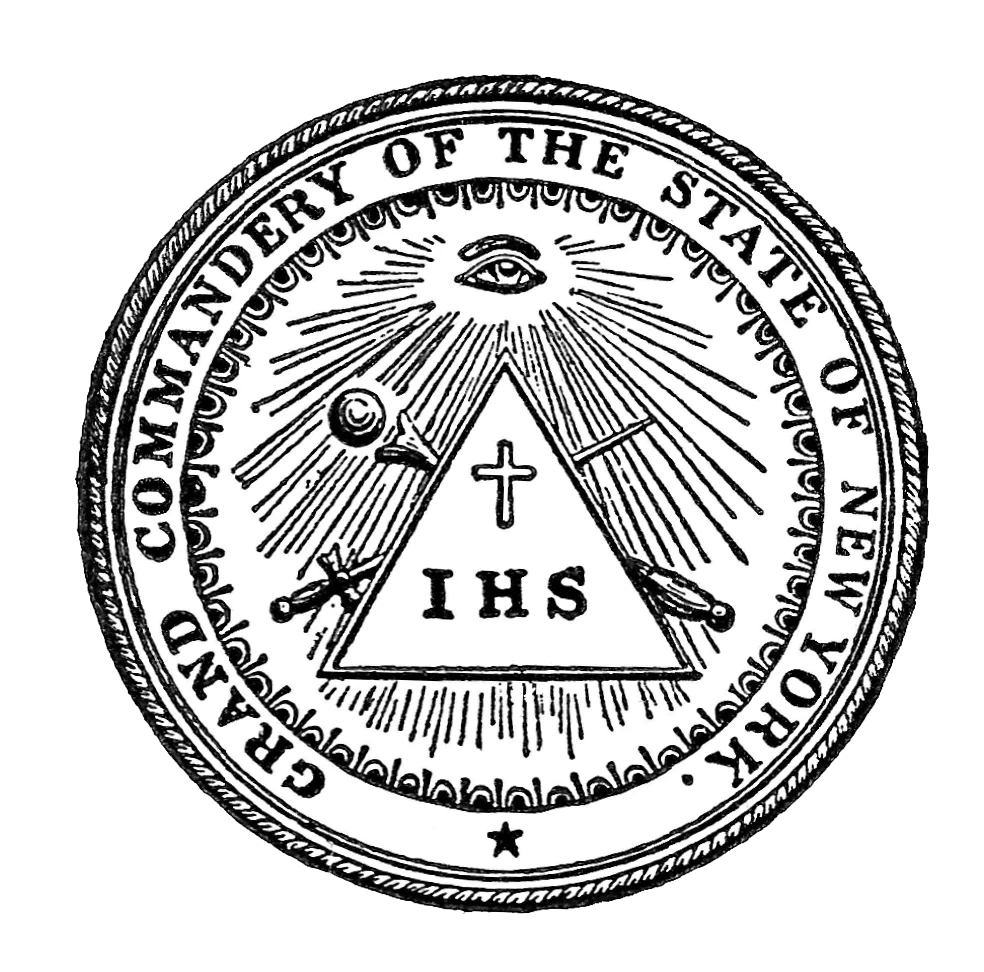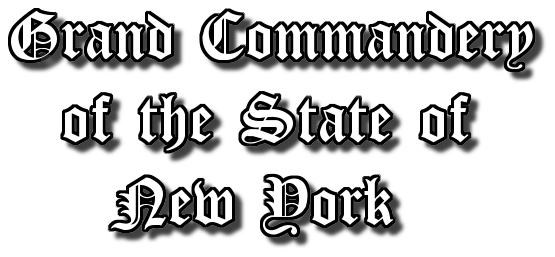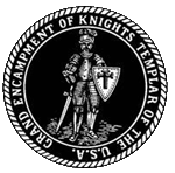History of the GRAND COMMANDERY,
KNIGHTS TEMPLAR State of New York
1814 – 2007
In colonial days, New York City was the starting point for Masonry in the State of New York. Establishing a definite starting date for Freemasonry in the colony of New York is extremely difficult. The craft had been in existence for many years prior to the formation of the Mother Grand Lodge in London in the year 1717. Undoubtedly many brethren at the time had received degrees in the British Isles or Europe and immigrated to America. The first authentic record we find is the appointment of Daniel Coxe as Provincial Grand Master of New York, New Jersey, and Pennsylvania by the Duke of Norfolk, June 5, 1730. In view of this appointment it is fair to presume that Freemasons were active in the Colony of New York. The first regular Lodge of which there is a record is St. John No. 2 (now No. 1) warranted December 7, 1757. The fact that it was given No.2 would indicate an earlier Lodge prior to 1757.The first newspaper reference to Freemasonry in New York appeared in the Independent Journal, Wednesday, December 28, 1785, reporting the anniversary celebration of the feast of St. John, the Evangelist. The article also states that the Knights Templar formed the escort for the Grand Lodge. From this we note that the Order of Knights Templar had been established in the Colony of New York and was a member of the Masonic family, the exact date of the first Encampment is unknown. There are many divergent theories regarding the origin of the present Order of Knights Templar. We find that the degree of Knights Templar was conferred under the control of Symbolic Lodges in Scotland, England, and Ireland in the early part of the eighteenth century. An interesting item appears in the proceedings of the Great Priory of England and Wales for the year 1941 page
1791
That on the 2th June, 1791, in London, was held the first general representative meeting of Masonic Knights Templar of England and that, therefore, I n the next month will fall the one hundred and fiftieth anniversary of the foundation of Great Priory. It is hoped that after the war a special meeting of official recognition of this will be held, when a short history of the Order during the last 150 years will be published. Some of these early Templars found their way to America either as soldiers or immigrants and when sufficient number assembled they assumed the authority to organize an Encampment. Each was absolutely independent, recognizing no supreme authority, because, in fact non existed at the time.
1814
In 1814 it became apparent that some control must be exercised, and the Grand Encampment of New York was formed. The preliminary meeting was held in New York, January 22, 1814. Elias Hicks, the first Grand Orator, outlined the purpose of the meeting as follows: A longer continuance of this state of things could be but productive of ill consequences, inasmuch as it was to be apprehended that these sorts of un-constituted associations, so rapidly increasing in numbers, would, sooner or later have lessened, if not entirely destroyed the commanding respect due to so dignified a degree as that of Knights Templar. Accordingly, the Sovereign Grand Consistory of Chiefs of Exalted Masonry fully impressed with the necessity and importance of this subject has at its session of the 22nd day of January A.D. 1814, as aforesaid, decreed by a unanimous vote, the establishment of a Grand Encampment of Sir Knights Templars and Appendant Orders for the State of New York. The first regular meeting was held in New York, June 18, 1814, at which time they ratified the action of the preliminary meeting on January 22nd, and elected DeWitt Clinton as Thrice Illustrious Grand Master. He was re-elected at each succeeding Annual Meeting until his death in 1828.DeWitt Clinton was a distinguished citizen of New York, prominent in the civil and political life of the State. The demand upon his time prevented his personal attendance at the meeting of the Grand Encampment. The only meeting over which he presided during his fourteen years as Grand Master, was in St. Johns Hall, New York, June 9, 1826.It is evident from the titles used, that the founders of the Grand Encampment were Scottish Rite Masons. They are referred to as the “Grand Consistory of the Chiefs of Exalted Masonry.” The title of the presiding officer was ‘Thrice Illustrious Grand Master” and the meeting place was the “Valley of New York “The Constitution adopted June 25, 1814, Article One, Section Three, read as follows: The Thrice Ill. Grand Master of the Grand Encampment, as soon as may be after his election, shall be admitted, gratis, a member of the Supreme Council of Grand Inspectors General, should he not belong to that Supreme Body. Section 4 of Article One provided that the Grand Master of Subordinate Encampments be made32nd degree Masons under the same conditions. In 1823 the word “Illustrious” is eliminated from he title, but the records do not relate as to the reason for the change. From this date there is no reference to the Scottish Rite. The Annual Meetings from 1814 to 1852, inclusive were held in New York City. The meeting place was Masonic Hall, 55 Nassau St. and later the Howard House in 1837.In 1814 a number of Encampments were operating in New York City and the Hudson Valley but due to the lack of definite information it is impossible to determine who they were. Thomas Smith Webb in his Freemasons Monitor, published in 1816, page 246 mentions four as follows: The Old Encampment – City of New York Jerusalem Encampment – City of New York Montgomery Encampment – Stillwater Temple Encampment – Albany The list is incomplete and inaccurate according to the historical record published by Robert Macoy, Grand Recorder of New York on the Proceedings for 1882, pages 118 -121, in which the following was reported: Old Encampment – sometimes called Grand Encampment or Morton Encampment – New York City St.. Peters Encampment – New York City Rising Sun Encampment, No.1 – New York City Encampments at Albany- Montgomery, Stillwater, Salem and Granville In the minutes of the Grand Encampment of the United States, June 20, 1816, the name of Ancient Encampment of New York, a name not appearing in New York records, and there is no record in New York of Jerusalem reported by Webb. Macoy cites as the source of his historical data, a perfect set of city directories from the year1785. He is of the opinion that the Templars referred to in the newspaper item of 1785 were of Morton Encampment, sometimes known as Old Encampment or Grand Encampment. The first published list of officers in the city directory for 1796 shows Jacob Morton as Grand Master. There is no record after 1810. At the Annual Conclave, May 22, 1815, Jacob Morton was elected an honorary member of Grand Encampment; St. Peters Encampment was organized prior to1700, as the city directory of that date shows a list of officers with John West as Grand Master, No record after 1801.Rising Sun Encampment, No. 1, the only early Encampment to bear that a number, was the most prominent of the period. The date of origin is unknown; except that it was founded in the early part of the nineteenth century, by a number of Sir Knights of the R.S.H., R.A.C. Macoy says the signification of these initials we are unable to give. It would appear, however, that they referred to Rising Sun Royal Arch Chapter. Then Encampment was represented at a meeting in Philadelphia, PA, February 15, 1814 called for the purpose of organizing a Grand Encampment in Pennsylvania. A charter of recognition was granted Pennsylvania, May 13, 1814. Macoy says they conferred the degrees of Ark, Mark, Mediterranean Pass, Red Cross, Knight Templar and Malta.
Utica Commandery #3 Press Conference on Feb 8 2023 anniversary date of our Chartering by Grand Master DeWitt Clinton. Governor of the State of New York who created the Erie Canal


